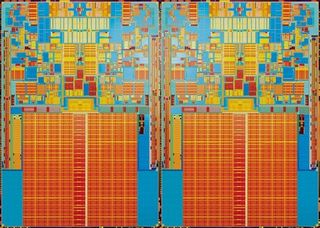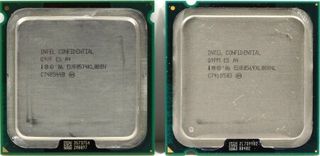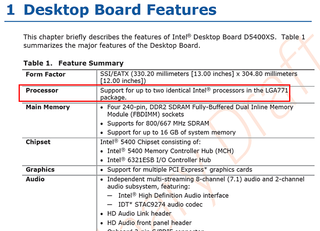Intel Skulltrail Part 2: Overclocking & Power
Processor-The QX9775 In Detail

A look at the Penryn die
The Skulltrail Core 2 Extreme QX9775 processor is clocked at 3.2 GHz, and each of its two dual-cores contains 6 MB of L2 cache for a total of 12 MB per CPU. It communicates with the 5400 Northbridge via a 400 MHz (1600QDR) FSB and, being an Extreme Edition model, features an unlocked multiplier.

On the left we have the new Skulltrail QX9775, with the QX9770 on th right.
| Processor Overview | ||||
|---|---|---|---|---|
| Model | QX9775 | QX9770 | QX9650 | Q6600 |
| Socket | 771 | 775 | 775 | 775 |
| Core | Yorkfield | Yorkfield | Yorkfield | Kentsfield |
| Clock Speed | 3.20 GHz | 3.20 GHz | 3.00 GHz | 2.40 GHz |
| Multiplier | unlocked | unlocked | unlocked | x9 |
| FSB | 1600QDR | 1600QDR | 1600QDR | 1066QDR |
| L2 Cache: | 12 MB | 12 MB | 12 MB | 8 MB |
| Process: | 45 nm | 45 nm | 45 nm | 65 nm |
The only difference between the single-socket desktop variant and its dual-socket version can be found on the back of the CPU package.

QX9775 vs. QX9770
Intel's Skulltrail motherboard, the D5400XS, features the LGA 771 socket used in the workstation and server segment. As a result, it is incompatible with desktop CPUs that use socket 775. The two indentations on the side of the CPU package also prevent the wrong CPU from being inserted.
Using socket 771 on the Skulltrail board results in a big advantage for the buyer, since it is compatible with any current Xeon processor. According to Intel, all 65-nm (Clovertown) and 45-nm (Harpertown) Xeons are supported.
Stay on the Cutting Edge
Join the experts who read Tom's Hardware for the inside track on enthusiast PC tech news — and have for over 25 years. We'll send breaking news and in-depth reviews of CPUs, GPUs, AI, maker hardware and more straight to your inbox.

Current page: Processor-The QX9775 In Detail
Prev Page Processors: Intel Core 2 Extreme QX9775 Next Page The Processor: Support For 43 Xeon ModelsMost Popular

